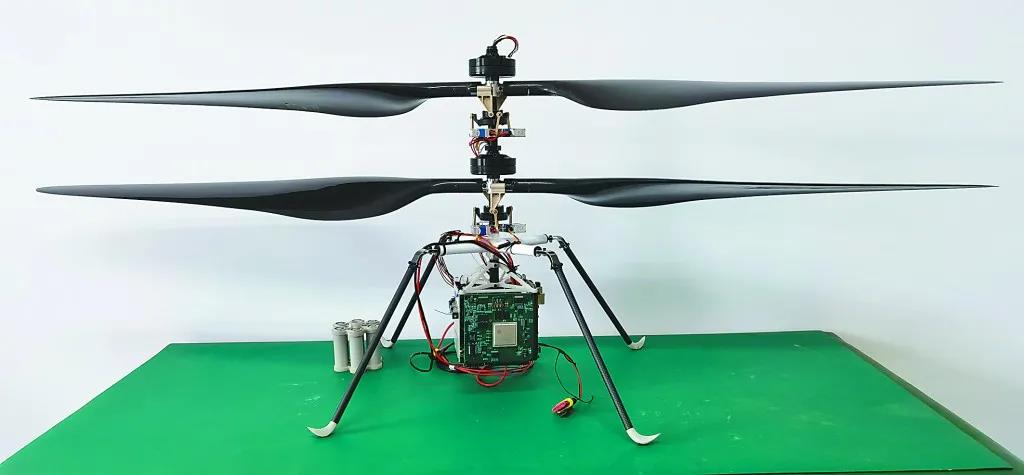Time: 2024-08-18
韋克威科技
Global Times Interview with the Mars Drone Development Team of the Chinese Academy of Sciences: Drones Lead a New Direction in Mars Exploration
Mars is becoming a hot topic for human deep space exploration in recent years, but the extreme environment on this red planet severely limits the exploration capabilities of traditional Mars rovers. Vehicles that can overcome the limitations of the rugged terrain on Mars are considered the development direction of the new generation of Mars rovers. On April 19th, the American unmanned helicopter "Smart" made its maiden flight on Mars. The prototype of the Chinese Academy of Sciences' Mars unmanned aerial vehicle, which is currently in the pre research stage, has also passed project acceptance recently. The project leader accepted an exclusive interview with a reporter from Global Times.
According to reports, the Mars UAV prototype was developed by a team led by Bian Chunjiang, a researcher at the National Space Science Center of the Chinese Academy of Sciences.When talking about the mission objectives of Mars unmanned aerial vehicles, Bian Chunjiang revealed, "The official name of our Mars unmanned aerial vehicle project is the 'Mars Surface Patrol Spectral Detection System'. In response to the problems of limited travel, slow forward speed, and small detection range of Mars rovers on the complex Martian surface, we propose a multispectral detection system that can patrol on the Martian surface. It is a patrol unmanned aerial vehicle carrying a miniature spectrometer, which can act as a navigator for Mars rovers and double the detection efficiency of Mars rovers. This project evaluates the feasibility of future large-scale patrol multispectral detection technology on the Martian surface through the development of a system prototypeAccording to Bian Chunjiang's introduction, in the future, Mars drones will mainly play two major roles. One is the 'Mars rover navigator'. Due to the complex terrain on the surface of Mars, even if the Mars rover is specially designed, there are still many dangerous areas that cannot be accessed. And the Mars drone can complete the imaging of the Martian surface within a radius of several hundred meters in one flight, quickly achieving precise grasp of the surrounding terrain and accurately guiding the Mars rover to safely and quickly travel.The second is the "Mars rover detection efficiency multiplier". The flying speed of Mars unmanned aerial vehicles is fast, which can quickly cover and grasp the surrounding surface morphology and composition characteristics, discover and guide Mars rovers to quickly approach high-value targets, achieve scientific exploration quickly and accurately, and promote the "doubling" of Mars rovers' ability to detect high-value targets.What is a Mars drone likeFrom the appearance of the announced prototype of the Mars drone, it appears to be a coaxial twin rotor unmanned helicopter with highly integrated energy, control, and payload systems directly beneath the wings.Why adopt such a design? Obviously, there are no runways available for traditional spacecraft to take off and land on Mars. From the perspective of simplifying the structure, Mars drones are also not suitable for takeoff methods such as catapults or skids. Bian Chunjiang revealed that, given the characteristics of Mars exploration and its surface environment, Mars unmanned aerial vehicles with vertical takeoff and landing capabilities have become the optimal choice. Currently, there are three types of vertical takeoff and landing unmanned aerial vehicles: single rotor tail rotor, multi rotor (mainly quadcopter), and coaxial twin rotor. Combined with the comprehensive evaluation of Mars gravity field and surface atmospheric characteristics, coaxial twin rotor is currently the best technical route for Mars unmanned aerial vehicles. "We believe that in the future, Mars unmanned aerial vehicles will mainly use this technical route.Bian Chunjiang said, "The characteristic of our Mars surface patrol spectral detection system is the highly integrated design of unmanned aerial vehicles and miniature multispectral detection payloads, which has the ability to conduct multispectral detection at ultra-low altitudes on Mars and quickly image the surfaceFacing numerous challenges in the futureHowever, unmanned helicopters that rely on rotors to provide lift face significant technical challenges when taking off and landing on Mars. This is because the atmosphere on Mars is very thin, and the atmospheric pressure on the surface of Mars is only 0.7% -0.8% of the atmospheric pressure on the Earth's surface, equivalent to the pressure at an altitude of 30000 to 40000 meters on the Earth's surface. It requires the rotor to operate at extremely high speeds to provide sufficient lift. In addition, it also needs to overcome challenges such as extremely low temperatures and autonomous charging on Mars. Due to the high technical difficulty involved, the US "Smart" unmanned helicopter did not carry any scientific equipment during this Mars mission, and focused on researching how to overcome many technical challenges such as insulation, charging, autonomous flight, and photography on Mars.Bian Chunjiang stated that the current research goal of the Mars unmanned aerial vehicle project is to break through the key technologies of the Mars surface patrol detection system, verify the feasibility of the technology, and lay the technical foundation for future spectral detection of Mars surface areas. The feasibility of the relevant technology has been verified through the development of a prototype of the Mars surface patrol spectral detection system and environmental simulation testing. In the future, the focus will be on the long-term survival issues of the complex environment on the surface of Mars, and relevant technical research and verification work will be carried out.He stated that the Mars Surface Patrol Spectral Detection System can achieve rapid and rough exploration of soil and rock composition on the Martian surface over a large range, helping the rover plan high-value exploration targets and efficient travel paths, guiding the rover to approach and achieve more efficient and safe fine exploration. He looks forward to its role in China's future Mars exploration missions. (Global Times reporter Deng Xiaoci)
Source: Guoke Huanyu
